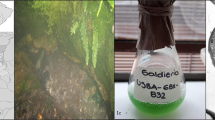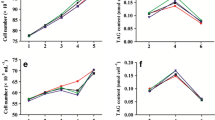Abstract
Changes in the eicosapentaenoic acid (EPA) content of Navicula saprophila grown photoautotrophically and mixotrophically with the addition of acetate were examined in terms of their growth progress. Among four conditions, mixotrophic conditions in CO2-enriched (about 2%) atmosphere gave a maximum EPA content. As sodium acetate was added to the growth medium, the EPA content increased and reached a maximum value of 34.6 mg EPA g-1 biomass in the early stationary growth phase. In contrast, under photoautotrophic conditions in CO2 enriched atmosphere, the EPA content decreased during this phase. EPA was localized as the fatty acid esters of monogalactosyl diacylglycerol, phosphatidylethanolamine and phosphatidylcholine, and the addition of acetate strongly enhanced production of the PC ester of EPA.
Similar content being viewed by others
References
Bligh EG, Dyer WJ (1959) A rapid method of total lipid extraction and purification. Can. J. Biochem. Physiol. 37: 911–917.
Cohen Z (1994) Production potential of eicosapentaenoic acid by Monodus subterraneus. J. Am. Oil Chem. Soc. 71: 941–945.
Cohen Z, Heimer YM (1990) Desaturase inhibition. Plant Physiol. 93: 347–349.
Dunstan GA, Volkman JK, Barrett SM, Leroi J, Jeffrey SW (1994) Essential polyunsaturated fatty acids from 14 species of diatom. Phytochemistry 35: 155–161.
Dyerberg J, Bang HO, Hjorne N (1975) Fatty acid composition of the plasma lipids in Greenland Eskimos. Am. J. Clin. Nutr. 28: 958–966.
Khozin I, Cohen Z (1996) Differential response of microalgae to the substituted pyridazinone, Sandoz 9785, reveal different pathways in the biosynthesis of eicosapentaenoic acid. Phytochemistry 42: 1025–1029.
Kitano M, Matsukawa R, Karube I (1997) Changes in eicosapentaenoic acid content of Navicula saprophila, Rhodomonas salina and Nitzschia sp. under mixotrophic conditions. J. appl. Phycol. 9: 559–563.
Opute FI (1974) Lipid and fatty acid composition of diatoms. J. exp. Bot. 25: 823–835.
Sato N, Nemoto Y, Furuya M. (1988) Lipids of Chattonella antiqua (Raphidophyceae). Plant physiol. Biochem. 26: 93–98.
Watanabe M, Nozaki H (1994) NIES-Collection, List of strains. National Institute for Environmental Studies, Environment Agency of Japan, Tsukuba, 45.
Yongmanitchai W, Ward OP (1991a) Growth of and omega-3 fatty acid production by Phaeodactylum tricornutum under different culture conditions. Appl. envir. Microbiol. 57: 419–425.
Yongmanitchai W, Ward OP (1991b) Screening of algae for potential alternative sources of eicosapentaenoic acid. Phytochemistry 30: 2963–2967.
Author information
Authors and Affiliations
Rights and permissions
About this article
Cite this article
Kitano, M., Matsukawa, R. & Karube, I. Enhanced eicosapentaenoic acid production by Navicula saprophila. Journal of Applied Phycology 10, 101–105 (1998). https://doi.org/10.1023/A:1008006722065
Issue Date:
DOI: https://doi.org/10.1023/A:1008006722065




